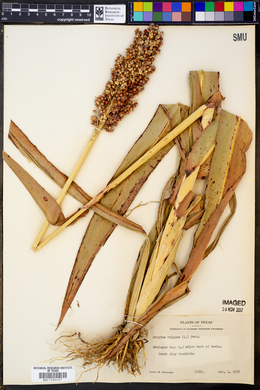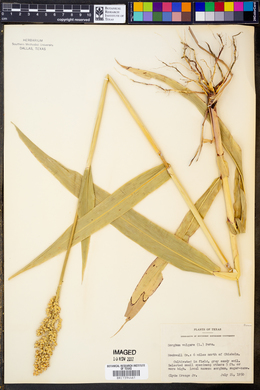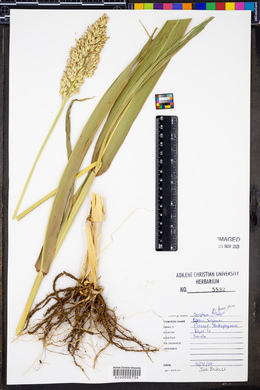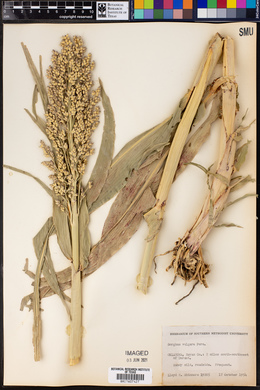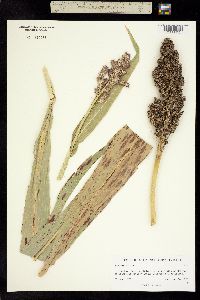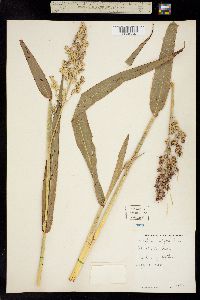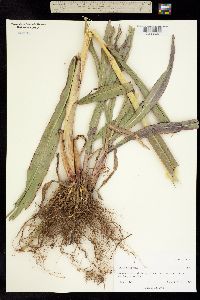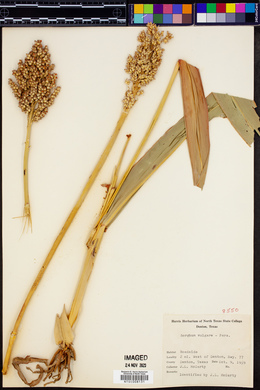Sorghum bicolor subsp. bicolor
|
|
|
|
Family: Poaceae
Grain Sorghum, more...Broomcorn, Sorghum, Sorgo
[Holcus bicolor L., moreHolcus sorghum L., Sorghum bicolor var. caffrorum (Retz.) Mohlenbrock, Sorghum caffrorum (Retz.) Beauv., Sorghum caudatum Stapf, Sorghum cernuum (Ard.) Host, Sorghum dochna (Forsk.) Snowden, Sorghum dochna var. melliferum Snowden, Sorghum dochna var. obovatum (Hack.) Snowden, Sorghum dochna var. pulchrum (Burkill ex C.Benson & C.K.Subba Rao) Snowden, Sorghum dochna var. technicum (Koern.) Snowden, Sorghum durra (Forsk.) Stapf, Sorghum saccharatum (L.) Moench, Sorghum subglabrescens Schweinf. & Aschers., Sorghum vulgare Pers., Sorghum vulgare var. caffrorum (Retz.) Hubbard & Rehd., Sorghum vulgare var. durra (Forsk.) Hubbard & Rehd., Sorghum vulgare var. roxburghii (Stapf) Haines, Sorghum vulgare var. saccharatum (L.) Boerl., Sorghum vulgare var. technicum (Koern.) Jáv.] |
Plants annual. Culms to 5 m or more, stout, frequently tillering. Inflorescence branches remaining intact at maturity, with 1-5 nodes. Sessile spikelets 3-9 mm long, 2-5 mm wide, elliptic to oblong. Caryopses exposed at maturity. All the cultivated sorghums are placed in Sorghum bicolor subsp. bicolor. Grain sorghums have short panicles and panicle branches, broomcorns have elongate panicles and panicle branches, and sweet sorghums or sorgho produce an abundance of sweet juice in their stems. For a more detailed treatment, see Harlan and de Wet (1972). Annual herb, often bearing side shoots 0.5 - 5.6 m tall Leaves: basal and along culm, with 1 - 4 mm long ligules and sometimes hairless blades 5 cm - 1 m long and 5 mm - 10 cm wide. Inflorescence: terminal, branched (panicle), 5 cm - 0.6 m long, 3 - 30 cm wide. The primary branches are whorled and end in spikes with two to seven pairs of spikelets. Fruit: a caryopsis that is exposed when mature. Culm: stout, 0.5 - 5 m long 1 - 5 cm across, sometimes branched, with hairless or appressed-hairy nodes and hairless internodes. Spikelets: either stalkless or stalked. The stalkless spikelets are bisexual, 3 - 9 mm long, 2 - 5 mm wide, elliptic to oblong, and compressed on the back. Stalked spikelets male or sterile, well-developed, 3 - 6 mm long. Glumes: leather-like to membranous, hairless or hairy, sometimes densely stiff-haired, with two usually winged longitudinal ridges. Florets: borne on stalkless spikelets have lower florets reduced to transparent lemmas, upper florets with anthers 2 - 2.8 mm long and lemmas that are unawned or have a bent and twisted awn 5 - 30 mm long. Similar species: Sorghum halepense is a perennial that bears rhizomes and has caryopses that are not exposed when mature. Other subspecies of Sorghum bicolor have unexposed mature caryopses and inflorescence branches that fall at maturity. Flowering: mid September to mid October Habitat and ecology: Introduced from Eurasia, this species is frequent along railroads and grain elevators and local near bird feeders or other areas with spilled seed. Occurence in the Chicago region: non-native Etymology: Sorghum comes from the plant's Italian name, sorgo. Bicolor means "of two colors." Author: The Morton Arboretum From Flora of Indiana (1940) by Charles C. Deam [Deam recognizes S. vulgare var. drummondii which currently is synonymized with S. bicolor. He ntoes that] this grass was first reported from Posey and Vanderburgh Counties in 1923. I have seen it as a common weed in the cornfields in Point Township of Posey County where it often overtopped the corn. A pioneer in that vicinity informed me that he thought it was introduced about 1890. …… Indiana Coefficient of Conservatism: C = null, non-native Wetland Indicator Status: UPL |





